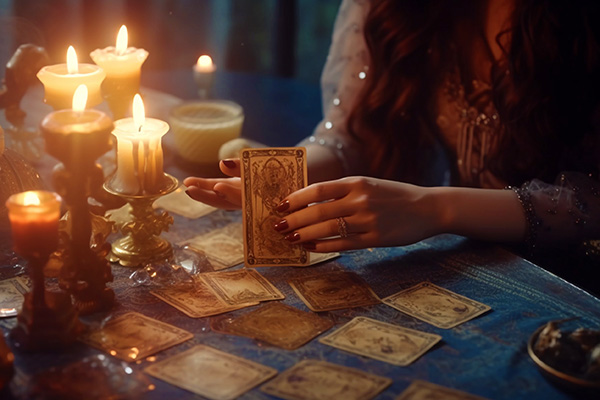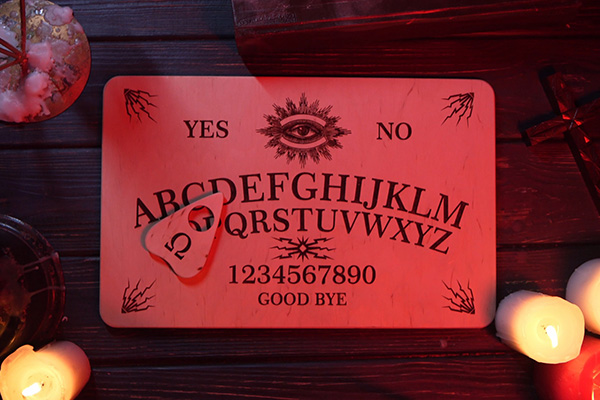mysticism
The Magic Of Dowsing Stands The Test Of Time
 Dowsing, also known as “divining” or “water witching,” is an ancient practice that uses a tool such as a pendulum or divining rod to locate what is hidden, most commonly underground water, minerals, or lost items. it is also a divination method used to tap into the unseen or mystical to gain spiritual, psychic, or energetic insights.
Dowsing, also known as “divining” or “water witching,” is an ancient practice that uses a tool such as a pendulum or divining rod to locate what is hidden, most commonly underground water, minerals, or lost items. it is also a divination method used to tap into the unseen or mystical to gain spiritual, psychic, or energetic insights.
While skeptics dismiss it as pseudoscience, dowsing has persisted in many cultures for thousands of years, standing the test of time as a mysterious blend of mysticism and physics. I believe its continued presence throughout history speaks to its importance and continued relevance in today’s technological society.
Dowsing has ancient roots dating back thousands of years, although its exact historical beginnings remain uncertain. Archaeological evidence suggests that the practice dates back to ancient Egypt and China, where early civilizations used rudimentary dowsing techniques to locate water and minerals. Cave paintings in North Africa from around 8000 B.C. depict people holding forked sticks, which many experts believe may be dowsing rods.
The ancient Greeks and Romans were also familiar with dowsing, especially for locating underground water sources. They considered the dowsing rod or pendulum a sacred tool capable of tapping into hidden energies. It was believed that certain materials, especially wood or metal, could act as conduits for detecting invisible forces in the earth.
In the Middle Ages, dowsing became more widely practiced in Europe, often by miners searching for metal veins, especially during the mining booms in Germany and England. However, due to its inexplicable, mystical nature, dowsing also increasingly became associated with the occult and witchcraft, leading to its condemnation by the church.
Honor Your Pagan Heritage This Halloween
 Samhain holds special significance for those who practiced paganism in a past life, especially those who were involved in magical practices as seers, soothsayers, druids, and witches.
Samhain holds special significance for those who practiced paganism in a past life, especially those who were involved in magical practices as seers, soothsayers, druids, and witches.
For us, this time of year evokes a deep sense of nostalgia, spiritual reorientation, and a return to ancient wisdom as the veil between worlds thins and we reconnect with our ancestors and the spirit realms.
Samhain is an ancient Celtic festival marking the end of the harvest season and the beginning of winter, traditionally celebrated from October 31 to November 1. It is one of the four great Gaelic seasonal festivals, along with Imbolc (February 1), Beltane (May 1), and Lughnasadh (August 1).
In Celtic tradition, Samhain (pronounced “sow-in”) is a liminal time when the boundary between the physical and spiritual worlds is thinner, allowing the spirits of our deceased loved ones, ancestors, and other spirits to cross over more easily.
In ancient times people would light fires and wear costumes to ward off harmful spirits, while also honoring their ancestors with offerings of food and drink.
Samhain is considered the origin of modern Halloween traditions, although Halloween has evolved and incorporated elements from other cultures to become a mostly secular and commercial holiday. For Neopagans and Wiccans, Samhain remains an important festival for honoring the dead, celebrating the cycle of life, death, and rebirth, and connecting more deeply with the spirit realm.
A Samhain Invitation From The Faeries
 Fairies love fun and joyful games in the great outdoors, even during the darker seasons of the year. I am reminded of this every year at this time when the veil between the worlds thins during the mystical season of Samhain and Halloween.
Fairies love fun and joyful games in the great outdoors, even during the darker seasons of the year. I am reminded of this every year at this time when the veil between the worlds thins during the mystical season of Samhain and Halloween.
If you’re currently experiencing a highly creative period or feeling called to get out into nature, even if it’s just to your garden before the weather gets too cold, there’s a good chance you’re also being invited to have some fun and free-spirited playtime with the fairies.
It is easiest for us to connect with the Faeries or Fae during the times of the year when the seasonal energy portals are open at the cross-quarter holidays of the Summer and Winter Solstices and the Spring and Fall Equinoxes.
These seasonal transitions are also traditionally celebrated in the ancient pagan festivals and religious holy days of Imbolc (St. Brigid’s Day) on February 1st, Ostara (Easter) on around March 21st, Beltane (St. Walburga’s Day) on May 1st, Litha (St. John’s Day) around June 20th or 21st, Lammas (Day of Bread) on August 1st, and Samhain (All Saints’ Day) on October 31st.
Traditionally celebrated as a time to honor our ancestors and reflect on the cycle of life and death, Samhain on October 31st marks the halfway point between the Autumnal Equinox and the Winter Solstice. It is a special time that invites us to step beyond the ordinary into the realm of magic and mysticism. The lingering echoes of autumn and the approaching winter in the Northern Hemisphere also foster a sense of introspection and connection to nature, making it an optimal time to commune with the ethereal elementals of nature.
Serendipity, Synchronicity And The Symphony of Life
 Something magical happened yesterday that reminded me of the many serendipities and synchronicities that miraculously unfold in our lives every day without us even noticing. We are in the right place, at the right time, doing the right thing more often than we realize – and it is no accident or coincidence.
Something magical happened yesterday that reminded me of the many serendipities and synchronicities that miraculously unfold in our lives every day without us even noticing. We are in the right place, at the right time, doing the right thing more often than we realize – and it is no accident or coincidence.
There are many moments in our daily lives that seem to happen by luck or chance, yet they are perfectly timed events that have been orchestrated just for us.
These experiences, which many call “fate” or “coincidence,” are certainly not random occurrences. They are part of the intricate symphony of universal flow and divine order that weaves together the everyday magic of serendipity and the miracle of synchronicity for our highest good.
Yesterday I had a long list of errands to run downtown, two of which were on the same street. My intention was to first pick up something from a courier service and then drop off some household items I wanted to donate at a nearby animal charity shop.
However, on the way to the courier, I took a turn that I do not normally take, which took me directly to the charity shop instead. I was relieved to find a parking spot right outside the door as I had some heavy boxes and crates to unload. How ‘lucky’ that there was a perfect parking space waiting just for me, I thought.
But my ‘wrong’ turn turned out to be not only a blessing in disguise, but also a little miracle that kept on giving. Because I arrived at the store earlier than I had originally planned, I “accidentally” ran into a customer in the shop who was in the process of purchasing the kitchen blender I had donated to the charity over a month ago.
The Soul Secrets Of Your Known Name Number
 Numerology, the ancient mystical study of numbers and its influence on our daily existence, goes far beyond calculating the meaning of your birth date.
Numerology, the ancient mystical study of numbers and its influence on our daily existence, goes far beyond calculating the meaning of your birth date.
While many people are familiar with the concept of the life path number, which is derived from one’s birth date, few realize that their known name number also holds profound insights into their character, destiny, and spiritual journey.
Also known as the expression number, the calculation of this number is a core component of numerology used by practitioners to explore one’s personality, potential, and life path. Calculating this number can be eye-opening and transformative.
Metaphysically, names are not arbitrary; they are energetic vibrations that carry specific meanings and influences.
Your known name is the name you go by in everyday life, whether it is the name your parents gave you at birth or a nickname that has stuck with you over time.
The name you identify with carries an energetic signature that reveals much about your personality, your purpose, and the unique challenges or gifts you may encounter in this lifetime.
In the practice of numerology, the letters in your name are assigned numerical values based on a system known as the Pythagorean Number Table, where each letter corresponds to a number from 1 to 9. By adding up the numbers associated with the letters in your known name, you can uncover several key numbers that offer insight into your personality, strengths, and life purpose.
The Timeless Appeal Of Tarot Divination
 I have yet to meet a spiritually-minded person who does not like the Tarot, or at least is not a little intrigued by this famous deck of cards.
I have yet to meet a spiritually-minded person who does not like the Tarot, or at least is not a little intrigued by this famous deck of cards.
The Tarot is arguably the world’s most popular and widely used divination tool, renowned for its rich symbolism and the depth of insight it offers. As an esoteric tradition dating back centuries, the Tarot has evolved into a diverse, sophisticated system of divination used by people from all walks of life to explore the mysteries of the mind, spirit, and the future.
Unlike some other forms of divination that require specialized knowledge or tools, the Tarot is accessible to both beginners and seasoned practitioners, offering a unique blend of art, intuition, mysticism, and storytelling. Its versatility allows it to address a wide range of questions, from personal and spiritual dilemmas to broader societal issues, making it a go-to resource for those seeking guidance, clarity, and self-discovery in an ever-changing world.
Each of the 78 cards in a Tarot deck is loaded with symbolic imagery and archetypal meanings that can be interpreted on multiple levels, from the deeply psychological to the spiritual and mystical. This layered symbolism allows diviners to explore personal dilemmas, spiritual growth, and the mysteries of life.
Unlike other divination tools that may rely on more rigid systems, Tarot offers a fluid framework that adapts to the reader’s intuition, personal beliefs, and level of psychic ability, making it accessible to people of diverse backgrounds and spiritual practices.
